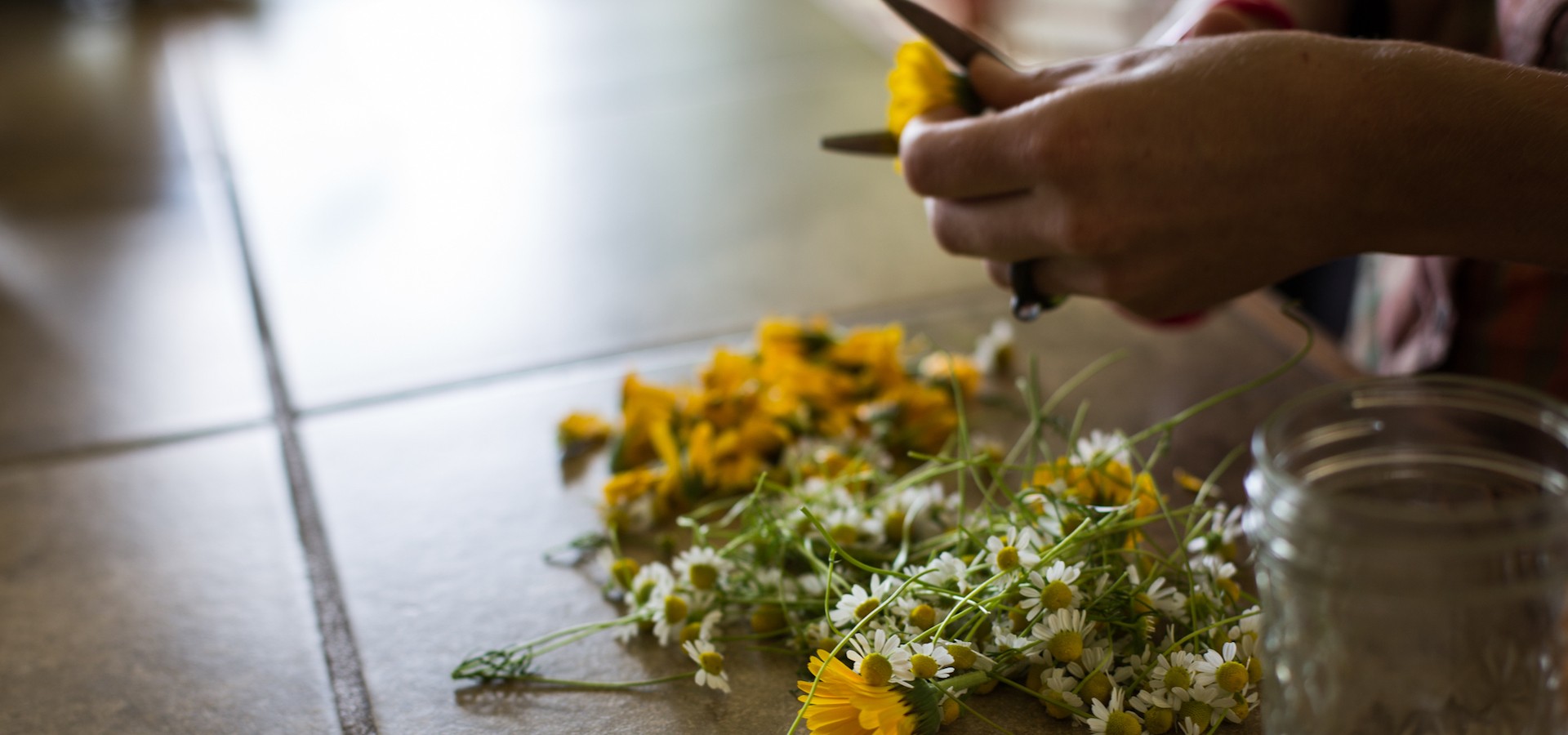Planting an herb garden is the perfect way to bring in the spring, and we humans have been doing it for thousands of years.
The ancients believed that every one of us can speak the language of the plants. That we can learn how to harness their medicines by spending focused time with them — just like cultivating a relationship with a new friend!
What’s fascinating about this sacred belief is that it’s being proven by modern science.
Get this: There’s an abundance of scientific evidence that supports the health benefits of gardening. The data shows that tending to flowers and simply cohabitating with nature can calm anxiety, lift symptoms of depression and lower blood pressure! The subtle aromas from plants create an atmosphere of ease, while the meditation of working outside in nature has a number of its own physical and mental benefits.
Not to mention the amazing flavor and healing nutrients that these fresh herbs bring to every meal.
Ready to create your own herb garden this spring?
Here are 5 healing herbs that are easy to grow, no matter where you live.
#1 Peppermint (or anything from the mint family — rosemary, lemon balm, etc.)
I consider peppermint an absolute must-have in the garden and in my life. Peppermint is an amazing ally for flu season because it is known to break fevers, soothe pain and calm stomach aches in record time.
Peppermint (Mentha x piperita) is so low-maintenance that you’ll hardly have to pay attention to it and it will still thrive. They grow very quickly, and even more so if you regularly pluck their abundant leaves for teas or for culinary purposes. (Just remember to cut gently at the stem and not take too much too soon or you will damage the plant.)
*Peppermint likes gritty, moist soil and partial sunlight.
#2 Marigold (aka Calendula officinalis)
These gorgeous golden flowers pop up in early summer if the seeds are tended to throughout the spring. Their petals are a powerful topical healer. Calendula is appropriate for any skin type. It can heal rashes, acne, minor scratches and bug bites. Taken as a tea, marigold petals help move lymphatic fluid properly to stimulate detoxification.
Plant these ASAP and see them sprout and bloom in the early summer. Give each seed about 12-18 square inches and bury them 1/4 inch into loamy, well-drained soil. Water regularly to keep the dirt moist, but not drenched.
Read more about Spring Medicine for the Soul
#3 Chamomile
Chamomile (Chamaemelum nobile) is a crowd pleaser for many reasons. Their small white petals spark joy in anyone who sees them. Their pleasant aroma is calming. As a tea, they quell anxious stomach aches, bring comfort to sick kiddos, and relaxes tense muscles.
Chamomile grows well in almost any climate — but they are easier to start from a plant than seed. They are incredibly easy to take care of. They are drought-tolerant and you don’t really need to baby them once they’ve grown out.
*The strong aroma of chamomile makes them the ideal partner to any vegetable patch because they ward off critters and insects!
#4 Lavender
Lavender (Lavandula angustifolia)is usually the first green medicine that pops into people’s minds when they think of calming herbs. They’re relaxing both internally and topically. The scent of lavender has been proven to bring down cortisol levels, which are behind our fight or flight hormone reflex. Added to oils, creams and salves, lavender is a powerful muscle relaxant and wound healer. But its legendary use has been to invoke lively dreams by promoting deep sleep.
Best grown from clippings of a mature bush, lavender grows and solidifies itself quickly. Because of their resilient nature, lavender is best planted at least 2 feet apart. It grows best in drier soils, so keep that in mind as you’re tending your garden. Add lots of mulch to help the soil drain, if you live in a city where it rains often.
*Lavender attracts pollinators of all kinds, making your backyard a sanctuary for local butterflies, bees and hummingbirds,
#5 Dandelions – Let them grow!
To quote my friend, Rosalee de la Foret of LearningHerbs, “lawn purists” have poisoned this beloved herbal remedy for decades, but it continues to grow.
Truly every part of a dandelion (Taraxacum officinale) is medicinal. It’s widely respected as one of the premiere detox herbs, and decoction tea made of its roots is a great diet drink that helps you burn fat.
If you haven’t tried this yet, fresh dandelion leaves are an amazing addition to salads and pestos to give a little bit of bite to sweeter recipes.
They’re highly medicinal and extremely flavorful when prepared the right way, BUT it’s the blooms and fuzzy seeds that bring giggles and laughter to children.
For all these reasons, I truly believe that dandelions should be protected.
With these 5 easy herbs-to-cultivate, you’ll have a living medicine sanctuary that you can turn to for relief from everyday ailments.
Last, but not least…
If you ever feel confused by what you’re ‘supposed’ to eat, you’re not alone. At almost every corner, you’ll find passionate followers of keto, high carb, low carb, high fat, low fat, paleo, raw, vegan, gluten-free, and just about every other dietary approach under the sun.
But what diet is right for YOU?
Thankfully, my friends John and Ocean Robbins have created the incredibly insightful Food Revolution Summit where they interview 24 leading experts in the fields of nutrition and wellness.
During this online event, you’ll learn the science and practical habits of eating well. You’ll learn how to select foods that can enhance your immune health, prevent disease, and just make you feel good because they’re so nourishing.
Click here to reserve your spot for free!
Seriously, there’s a wealth of knowledge here that I, for one, am stoked to draw from for my own life. I hope to see you there.
Stay curious,
Nick Polizzi
Host of Remedy: Ancient Medicine for Modern Illness
& Founder of The Sacred Science




11 Responses
Hi Nick,
Thank you for this and all other help you supply. Today my not so young body hurts a bit from gardening. So much to do: flowers, vegetables.
Dandelion!! I pick the leaves for salads and also to infuse into my home made apple cider vinegar. It is absolutely everywhere. Whatever does not grow on my property grows just outside my fence, as I am surrounded by ‘wilderness’ on 3 sides. I can certainly use all the ideas you have regarding plants and herbs.
Hello there,
Thanks for commenting and hope your body recovers well from all that wonderful gardening! Reads like you have a full operation there – sowing, growing, cultivating, harvesting, processing, enjoying! Keep reading through the blog, we have many articles about “backyard medicine” 🙂
Do these grow well in an aeroponic garden?
Hi Kimberly,
Many plants do well in Aeroponic growing systems, here is a resource for you: https://homeguides.sfgate.com/grow-aeroponic-herbs-25676.html. Hope this helps!
#2 Marigold (aka Calendula)
please kindly note calendula and marigold are two different plants and have their specific medicinal properties
Kids at home =more soda replacement for thirstiness.
When you use a teaball, stevia LEAF can be used to help cut back on the glucose (usually sugar). I use 1/4 cup rooibos, 1/2 cup peppermint leaf, 1 round TB stevia leaf and 4 Qts. Water, and finish off each serving with a splash of sparkling soda mineral water.
Hi Nick,
I miss getting your e-mails. Not sure why they stopped because e-mail is the only option we have for connecting with you. We live somewhat remote with only dial-up for internet service.
Dandelion Latte is the best. Roast the cleaned, dry, and chopped root in a 315 F oven for 15 mins. Boil 4 cups water with pieces of cinnamon stick and a splash of maple syrup. Add the roasted root to the water and simmer for a 10 – 15 minutes. Add 1 cup nondairy milk heat to desired temp, strain and enjoy 🙂
Hope to get connected soon.
Marigolds and Calendula are not one and the same.
How many varieties of marigolds are there? 56 species
There are around 56 species of marigold found all across the world. Marigold has 2 genera which are referred to as Tagetes and Calendula.
Although both are members of the sunflower (Asteraceae) family, marigolds are members of the Tagetes genus, which includes at least 50 species, while calendula are members of the Calendula genus, a smaller genus with only 15 to 20 species.
Calendula and marigold are NOT the same thing. Calendula is sometimes called “pot marigold” but it is different from the marigolds that you see all summer at the garden centers. They have different botanical names. Calendula is Calendula officinalis; marigold is Tagetes (various species). That being said they may not have the same medicinal properties and are not interchangable.
This info is great as I am about to plant my first balcony garden. I am loving your article and recipes in comments area. Thank you to all
I found the inf. Very interesting. I would like to get more inf. I’m going to start my herbs garden this summer.